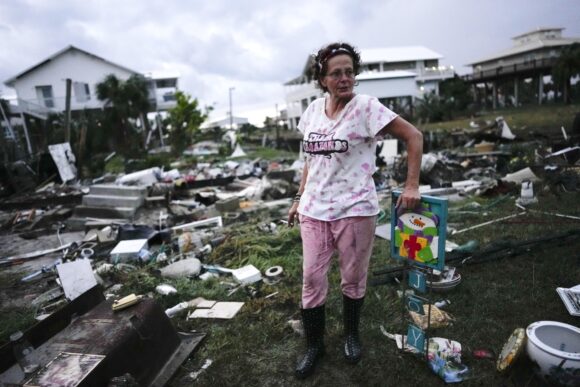The property insurance industry breathed a sigh of relief after Hurricane Idalia landed in a less-populated part of the coast, triggering just a few billion dollars in losses. But regulators have urged insurers to make sure that claims from the area are taken care of.
Insurance agents in Florida’s Big Bend area, the hardest-hit region, are applauding those efforts, urging carriers to remember the small-town homeowners and businesses that were damaged by the storm.
“It couldn’t have hit in a better spot as far as industry losses are concerned. But there’s still a lot of significant damage here in Taylor and Madison counties,” said Jeffrey Rush, a commercial lines agent in Live Oak, Florida, with the George Odiorne Insurance Agency.
The storm spared his own house but knocked down a pine tree that Rush planted in 1988.
“The coast got beat up pretty bad, Horseshoe Beach and Suwannee, especially,” said Todd Bryant, senior vice president at Nature Coast Insurance, an agency with three offices in the area.
He compared the surge to the famous “Storm of the Century,” a non-hurricane event that inundated parts of the South in March 1993.
Idalia may not be a storm for the ages, but state officials said they were taking it seriously. Florida Insurance Commissioner Michael Yaworsky issued an emergency order, giving insureds two months’ grace period on policy cancellations and nonrenewals. All cancellation notices mailed in the 10 days preceding Sept. 1 must be withdrawn and reissued after Oct. 31, the order states.
“In the coming weeks, OIR will work in overdrive to both support policyholders in impacted areas and continue our efforts to promote a robust insurance market for consumers,” Yaworsky said in a statement.
Florida’s Department of Financial Services, which encompasses the OIR, also rushed to set up insurance villages just days after the storm hit, in Perry and Fanning Springs, to assist insureds with claims.
“Please be advised that these locations are outdoors and will not have power available,” reads an email from DFS’ Greg Thomas to insurers. “Please bring appropriate equipment to conduct operations in a parking lot.”
Insurance villages have become the norm after hurricanes, with tents and tables set up to handle claims processing. But Friday’s announcement came on a Friday afternoon, giving insurers just a few hours’ notice and catching some off guard. One executive suggested that Florida CFO Jimmy Patronis may have decided to move up the timetable because U.S. President Joe Biden was due to tour the water-slogged area Saturday morning, with national media in tow.
Florida insurers are facing a little more scrutiny and new reporting requirements, after the state Legislature this year approved the Insurer Accountability Act.
The law was passed after three independent adjusters charged that several carriers and their claims firms had inappropriately altered damage estimates from Hurricane Ian and other storms. Insurers are now required to abide by industry best practices and follow their own claims handling manuals.
As of Sunday, Sept. 3, four days after the storm hit, OIR reported that more than 10,500 Idalia claims had been filed. About 75% of those were for residential property. Some 455 had already been closed with payment, while 435 were closed without payment.
By comparison, OIR has recorded 739,771 claims from last year’s powerful Hurricane Ian, with more than half of those closed with payments by the end of June this year.
Many of the claims from Idalia are expected to be flood-related, although only a fraction of homes and businesses in the Big Bend region had obtained flood coverage before the storm hit, experts said. RMS, part of Moody’s Investment Service, has estimated losses to the National Flood Insurance Program to be about $500 million.
“There’s a lot of flooding in that area from the storm surge,” said John Gragson, senior vice president of claims operations for Sedgwick, the national claims management firm. The firm had adjusters on the ground, working for property insurers in Florida, Georgia and South Carolina.
“But by and large, the wind field was not as extensive as was expected,” Gragson said.
Others in the region agreed that the industry had largely dodged a bullet, thanks to the path of the storm and reduced windspeeds as it moved across the three coastal states. A testament to that came from the South Carolina Wind and Hail Underwriting Association, which writes residential property in coastal counties.
“We’ve had just two claims, so far,” Randy Mason, claims director for the association, said Friday. “It was a lot quieter than we expected.”
Insurers in the Carolinas were “all breathing a sigh of relief,” and counting their blessings, said Russ Dubisky, an official with the South Carolina Insurance Association and the Insurance Federation of North Carolina.
Coastal Georgia was in similar shape after Idalia blew through, with relatively minor claims.
“Every claim we’ve seen so far is from trees falling on roofs or on vehicles,” said Renata Lee, an agent in Waycross, Georgia.
The wind insurer that may see the most losses in Florida is the state-created insurer of last resort, Citizens Property Insurance Corp.
Topics Carriers Agencies Florida Claims Georgia South Carolina
Was this article valuable?
Here are more articles you may enjoy.



 Aon Extends Employment Agreement With CEO Case
Aon Extends Employment Agreement With CEO Case  Howden US Tells Judge Brown & Brown Employees Fled Due to ‘Mistreatment’
Howden US Tells Judge Brown & Brown Employees Fled Due to ‘Mistreatment’  Is the AI Boom a Bubble Waiting to Pop? Here’s What History Says
Is the AI Boom a Bubble Waiting to Pop? Here’s What History Says  Nearly Half of 100 Largest P/C Insurers Destroy Value: ACORD
Nearly Half of 100 Largest P/C Insurers Destroy Value: ACORD 


